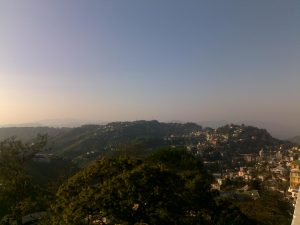[ad_1]
The Pulse | Diplomacy | Security | South Asia | Southeast Asia
New Delhi has refused to take steps that would antagonize the Tatmadaw following its February 1 putsch. Refugees fleeing Myanmar may well serve as a test for India.

Mizoram’s capital Aizawl.
Credit: Flickr/Joe Fanai
The Indian central government’s policy to block the entry of refugees from Myanmar and deporting them has been opposed by a state in the frontier region of the northeast that borders the disturbed country.
India’s northeastern state of Mizoram has urged the central government to review its policy on the refugees from Myanmar as they were escaping from their country in distress.
Speaking at the upper house (Rajya Sabha) of parliament, representative from the state K. Vanlalvana said that “sending them (refugees) back would mean killing them” while arguing that India ought to support establishment of democratic rights and principles. He made a case for a change of policy also before Vice President Venkaiah Naidu.
Vanlalvana is a member of parliament from the Mizo National Front (MNF), the ruling party in Mizoram, where the government had already started providing relief and shelter to the refugees from Myanmar.
The refugees have mostly escaped from the Chin state in Myanmar where the population shares ethnic ties with the tribes in Mizoram. More than 300 refugees have entered the state since the crackdown against anti-coup demonstrators began in Myanmar early last month. Police personnel comprise a large chunk of the refugees who fled the country after refusing to fire on the protestors.
As many as four states in India’s northeast share borders with Myanmar over 1643 kilometers that pass through some of the most rugged and inaccessible hilly terrains in the country. However, so far, refugees from the neighboring country have crossed over only to Mizoram and not to the other states.
Mizoram is no stranger to refugees from Myanmar. In 2017, hundreds of residents fleeing from army operations against Arakan Army in Chin State had crossed over to the state’s Lawngtlai district in the southern zone where they stayed for many months before leaving for their homes.
There are also over 50,000 Chin immigrants who had voluntarily settled in different districts of Mizoram over the past several decades for better economic opportunities.
On March 10, the central Ministry of Home Affairs instructed the border states in the northeast to identify the “illegal migrants” from Myanmar and begin the deportation process “expeditiously without delay.”
The ministry’s response came on the heels of a demand by Myanmar’s Tatmadaw that the police personnel who had sought refuge in Mizoram be deported. A letter written by Myanmar authorities to the Mizoram government pointed out that they had information that eight police personnel including a female officer had crossed into India.
New Delhi’s stance on the coup marks a sharp difference from the policy adopted in the aftermath of the bloody crackdown in 1988 when hundreds of pro-democracy activists were shot in Myanmar. India had opened relief camps in Manipur and Mizoram for activists fleeing the crackdown and later a parliamentary panel was informed by the government that none of them would be forced to return.
In 1992, India also joined a United Nations resolution sponsored by the U.S. and Western countries condemning the junta for its violations of human rights.
The policy towards the junta assumed a friendlier tone from the mid-1990s resulting in a flurry of high-level exchanges from both the countries and agreements over the next one-and-a-half decades.
Currently, a slew of projects is being implemented by the Indian government in Myanmar which includes the trilateral highway to Thailand and the Kaladan Multi Modal Transit Transport Project aimed at providing an outlet to the landlocked northeast region of India. Myanmar also occupies a vital position in India’s ambitious Act East Policy that aims to establish closer ties with the South East Asian countries among other components.
[ad_2]
Source link